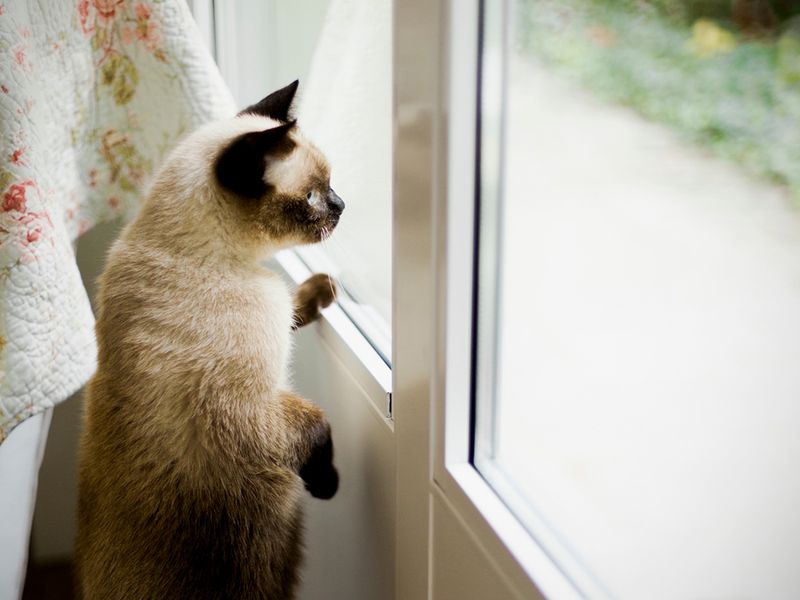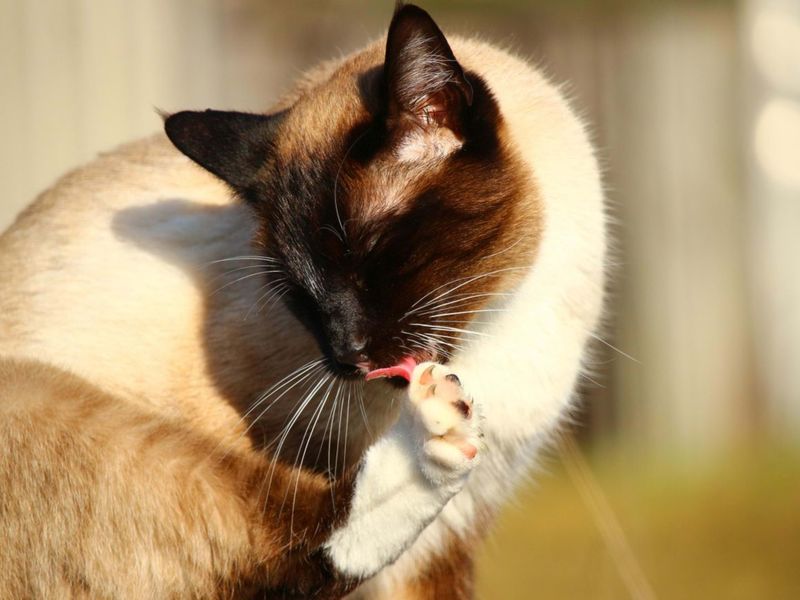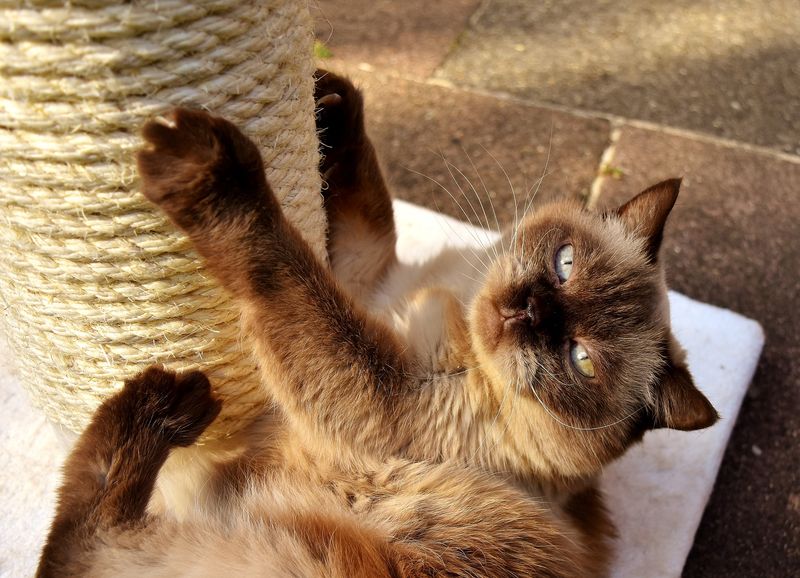📖 Table of Content:
- 1. Excessive Vocalization
- 2. Separation Anxiety
- 3. Territorial Aggression
- 4. Compulsive Behaviors
- 5. Destructive Scratching
- 6. Litter Box Avoidance
- 1. Mental & Physical Stimulation
- 2. Building a Predictable Routine
- 3. Interactive Play Before Bed
- 4. Addressing Separation Anxiety
- 5. Positive Reinforcement
- 6. Keeping Their Environment Enriching
Siamese cats are one of the most intelligent, loyal, and charismatic feline companions around. Their striking blue eyes, elegant frame, and communicative nature make them a favorite for cat lovers worldwide. However, beneath their beauty and brilliance lies a personality that requires thoughtful understanding and attentive care.
Owners of Siamese cats often find themselves both enchanted and challenged by their pet’s behavior. Unlike more independent breeds, Siamese cats thrive on interaction, stimulation, and companionship. When these needs aren’t met, behavioral issues can develop—sometimes subtly, and other times quite dramatically—leaving even experienced cat owners scratching their heads.
This article dives into six of the most common behavior issues found in Siamese cats and pairs each one with an expert-approved solution. With the right strategies, you can manage your cat’s quirks like a true cat whisperer. Understanding is the first step; after that, it’s all about communication, consistency, and care. Whether you’re a new Siamese parent or a seasoned feline friend, the guidance below will help foster a happier, more harmonious home for both you and your cat. Let’s explore what makes these cats tick—and how to guide them gently.
1. Excessive Vocalization
Endless meowing is a well-known trait of Siamese cats, but when it crosses into disruptive territory, it can signal a deeper need. Often, these vocalizations aren’t random; they are deliberate attempts to communicate boredom, loneliness, or a desire for attention. At night, their cries might reflect a disrupted sleep cycle or lack of mental engagement throughout the day. Vocalizations may also stem from hunger or a misplaced expectation of treats and attention. It’s essential not to reinforce the behavior by reacting emotionally or immediately. Instead, observe patterns—when and why they vocalize—and adjust your interaction schedule accordingly. Consultation with a vet is also wise to rule out any health-related triggers like hyperthyroidism or pain.
2. Separation Anxiety
Left alone for hours, a Siamese cat may become visibly distressed, showing signs like pacing, loud crying, or destructive chewing. Their intense bond with their human companions makes them more susceptible to separation anxiety than many other breeds. This attachment can turn problematic when regular departures, like going to work, provoke fear or panic. You might return home to find furniture clawed or litter box accidents used as a cry for attention. Over time, this emotional stress can lead to depression or aggressive outbursts toward other pets. Recognizing this early is critical, and watching for behavioral changes during your absence can provide clues. Gradual acclimation to being alone is often necessary to prevent emotional harm.
3. Territorial Aggression
Marking territory isn’t just a canine behavior—Siamese cats may show dominant behavior when they feel their space is under threat. New pets, visiting guests, or even a change in furniture layout can trigger displays of aggression. This might include swatting, biting, or even chasing other animals around the home. Some cats react by spraying or hissing when approached in what they perceive as “their zone.” Owners may notice the aggression peaking at certain times of day or near certain objects. Creating distinct zones for each pet or individual in the home can alleviate this tension. Addressing this behavior involves building trust and ensuring all pets feel safe and acknowledged.
4. Compulsive Behaviors
Over-grooming to the point of bald patches or repetitive movements like pacing can signal compulsive tendencies in Siamese cats. Such behaviors usually develop in response to chronic boredom, stress, or a lack of stimulation. These actions can become ritualistic and hard to interrupt once they’re ingrained. Left unchecked, the cat may injure itself or become withdrawn and less responsive to affection. Environmental triggers such as loud noises or lack of hiding places often exacerbate the issue. Providing varied enrichment and rotating activities helps reduce monotony that fuels these habits. Identifying the root cause—emotional or environmental—is key to developing a long-term solution.
5. Destructive Scratching
Furniture, curtains, and even walls may bear the brunt of a Siamese cat’s need to scratch, often frustrating their human companions. Scratching is a natural and necessary feline activity, helping with nail maintenance and territorial marking. However, if not redirected, it can quickly become destructive. Some cats scratch excessively due to anxiety or changes in routine. Without appropriate outlets like scratching posts, they’ll gravitate to the most textured or familiar surface. Ensuring these outlets are placed in prominent and accessible locations improves their usage. Discouraging destruction involves both deterrents and positive reinforcement when they use approved surfaces.
6. Litter Box Avoidance
Sudden avoidance of the litter box is one of the clearest signs something is amiss, either physically or emotionally. Cats may associate pain from a urinary tract infection with the box, causing them to avoid it in the future. A dirty, poorly located, or unscented box can also trigger avoidance. In multi-cat households, competition or intimidation can prevent one from accessing the litter box comfortably. You may notice your Siamese seeking out hidden corners or soft materials like laundry to relieve themselves. Keeping a clean, quiet, and accessible litter area with enough boxes for each cat is essential. Behavioral corrections should focus on reducing stress and encouraging positive associations with the litter area.
1. Mental & Physical Stimulation
Keeping a Siamese cat mentally and physically engaged is one of the most effective ways to prevent behavior problems. Incorporating daily playtime using interactive toys like wand teasers or laser pointers keeps their instincts sharp. Cat puzzle feeders challenge their intellect while providing entertainment and slow feeding benefits. Climbing structures, window hammocks, and tunnels offer opportunities for exploration and movement. Bored cats are far more likely to act out with scratching, yowling, or over-grooming. By rotating toys and introducing new challenges regularly, you mimic the mental stimulation they’d get in the wild. Maintaining this level of enrichment is crucial to long-term wellbeing. Remember, a tired Siamese is usually a happy and well-behaved one.
2. Building a Predictable Routine
Stability is comforting to Siamese cats, and a structured routine can significantly reduce anxiety-driven behaviors. Feeding them at the same times each day builds trust and helps regulate their internal clock. Predictable play sessions and cuddle times create positive anticipation and emotional security. Even small changes like moving their food bowl or delaying dinner can result in stress vocalizations or mood shifts. Creating a clear daily rhythm helps them feel in control of their environment. Owners may find that behavioral issues lessen as the cat becomes more confident in daily expectations. Routines serve as a language of consistency in a cat’s unpredictable world.
3. Interactive Play Before Bed
Evening zoomies or vocal demands can be tamed with a bit of energetic play before bedtime. Engaging your Siamese cat in a session that mimics hunting—chase, pounce, capture—satisfies their primal urges. Finishing the game with a small, protein-rich snack simulates the natural “hunt, eat, groom, sleep” cycle. Cats that exercise before sleeping are less likely to wake you up at night or cry from boredom. This nightly ritual strengthens your bond and improves their mood throughout the next day. It also helps you understand their preferred play styles and toys. Developing this into a nightly habit leads to better rest for everyone in the house.
4. Addressing Separation Anxiety
Gradual desensitization to your absence helps your cat feel more secure even when you’re gone. Begin by leaving the house for short periods, then slowly increase the duration. Leave behind a worn shirt or blanket with your scent to provide comfort in your absence. You can also play calming music or use pheromone diffusers to ease anxiety. Offering puzzle toys before departure helps associate your absence with fun rather than fear. Avoid making a big show when leaving or returning—it only heightens anticipation and stress. Establishing a calm, reassuring routine can significantly reduce the emotional toll of separation.
5. Positive Reinforcement
Reward-based training helps shape good behavior in Siamese cats, who respond well to affection and treats. Rather than scolding them for scratching furniture or vocalizing excessively, offer praise when they choose a better behavior. Timing is crucial—offer rewards immediately to reinforce the connection. Clicker training can be particularly effective for this breed due to their intelligence and desire to please. Avoid punishment, as it may damage trust or escalate anxiety. Teaching acceptable alternatives makes your expectations clear in a language they can understand. When consistently reinforced, these behaviors will begin to replace the unwanted ones naturally.
6. Keeping Their Environment Enriching
A stimulating environment encourages exploration and reduces the likelihood of stress-based behavior issues. Install perches at various heights so your cat can observe its surroundings and claim vertical territory. Strategic window placements offer hours of entertainment, especially with bird feeders outside. Rotate toys weekly and introduce novelty items like cat tunnels or cardboard castles. The more options your cat has to stay busy, the less likely it will become destructive or depressed. Environmental enrichment also fosters independence, reducing the risk of separation anxiety. A varied, responsive living space is one of the most powerful tools for behavior management.












